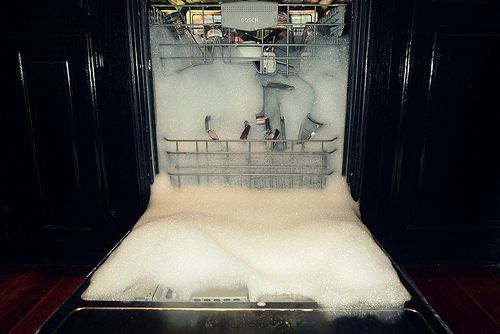Tugend, A., (2010). “For the Dishwasher’s Sake, Go Easy on the Detergent.” NY Times Online. Visited on November 04, 2010: http://www.nytimes.com/2010/03/13/your-money/13shortcuts.html
If dishwashers do not seem to be doing their job or if your clothes are not coming out as soft as you’d like them to, or if these machines break down easily, it is most likely due to “user error.” We throw in multiple fabric softener sheets because more is better. More isn’t better in this case! The excess sheets liquefy when the dryer gets hot and gum up the dryer. Most people use ten to fifteen times the amount of soap they need. This excess soap is detrimental to the life of the machines.
This article has some clear implications for interaction and interface design. User errors are likely to happen. Even if you have a manual with detailed instructions, the chances of somebody reading that manual are very slim. Even if they read it, they are still likely to err. How can design inculcate the right usage in the user? In this case, what can design do to prevent errors resulting from the ‘More is better’ p-prim?
Possible Interaction Design Solutions:
Solutions could be proactive or reactive. Perhaps we could have a soap inlet or receiver that limits the amount of soap that can be used. If there is still a way to get the detergent in, perhaps there could be a filter that lets just the right amount of soap pass through, and discards the rest. Similarly, a slit big enough to accommodate only one sheet for a load would probably ensure appropriate use of fabric softener sheets. These are all proactive measures to prevent the error from happening. If there is still room for error, perhaps a pesky alarm can be built in to notify the user if there is too much soap. Although this is reactive, it may work proactively. The fear of letting it go off should itself be sufficient to deter the use of more soap.
In the case of a dishwasher, the way in which dishes are loaded is also important to its performance. Most of the dish racks inside dishwashers have allocated spaces to assist with correct loading. For example, large gaps in the rack allow only big utensils to be placed in certain areas where small ones would fall through. But users can still load it incorrectly. They can balance small utensils over the large ones, thus preventing the inner surfaces of the small utensils from getting cleansed. Making the layout too rigid would make it unusable. Could there be a dishwasher that cleans everything—delivers the water, the soap and the correct water pressure—regardless of how the dishes are loaded? Could a network of flexible tubes carrying water and soap intertwine themselves with the dishes and distribute the cleansing to all the utensils?

